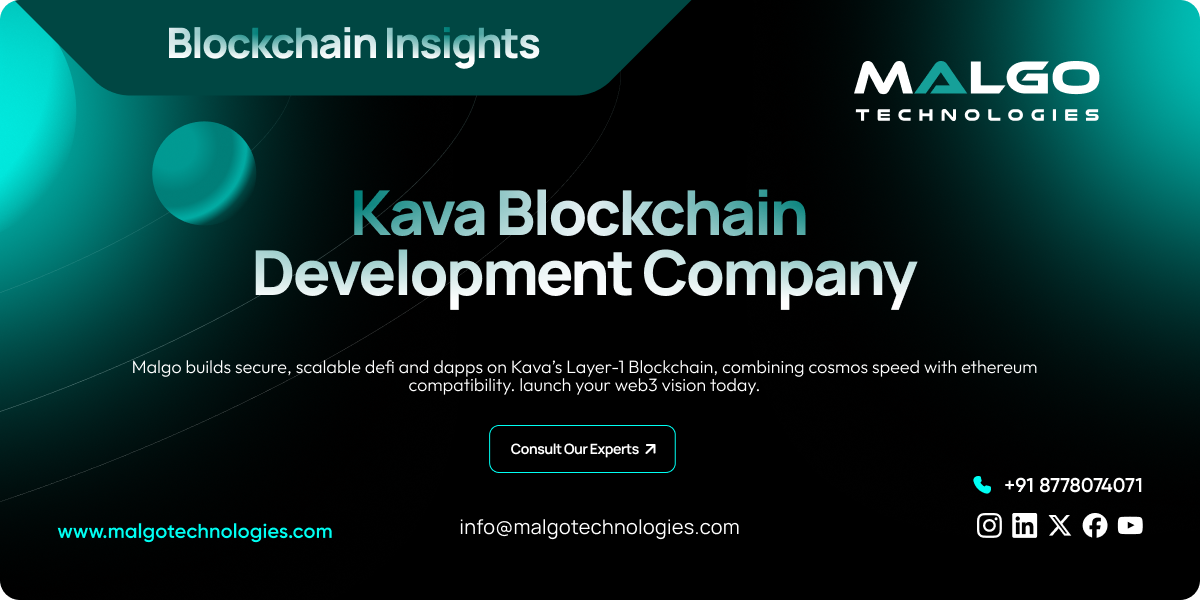Introduction
Kava is gaining recognition as a powerful platform for developers looking to build secure, scalable, and interoperable blockchain applications. With its compatibility with both the Ethereum Virtual Machine (EVM) and Cosmos SDK, it offers an ideal environment for launching DeFi products that need high performance and flexibility.
What Is Kava Blockchain?
Kava is a Layer-1 blockchain that brings together the strengths of Ethereum and Cosmos. It allows developers to deploy smart contracts using Solidity and gain access to the fast and low-cost infrastructure provided by the Cosmos SDK. This focus on blockchain development enhances its dual support, creating a solid foundation for cross-chain applications, especially in financial services and decentralized exchanges.
Why Developers Build on Kava Blockchain?
Kava offers a unique environment that balances performance and decentralization. Developers choose Kava because it provides access to both Ethereum’s large toolset and Cosmos’s efficient consensus protocol. The built-in support for interoperability makes Kava an appealing choice for teams building DeFi, NFT, and GameFi applications.
Why is Kava Blockchain Considered a Top Choice for DeFi Development?
Kava’s on-chain governance, seamless multi-chain integrations, and low transaction costs make it a preferred choice for launching DeFi solutions. Its architecture is optimized for projects that demand high throughput and stable infrastructure, which are essential for decentralized lending, borrowing, and trading systems.
Kava Blockchain Development Services
Kava Blockchain Consulting
Kava consulting services help define technical approaches and strategic solutions that align with your blockchain project needs. Consultants analyze the compatibility of features like smart contract execution and cross-chain functionality to suggest the best way to move forward.
Custom dApp Development for DeFi
Decentralized applications built on Kava benefit from its high speed and low fees. Developers can design dApps for lending, trading, and liquidity provision using Solidity and deploy them with the support of Cosmos infrastructure.
Smart Contract Development on Kava
Smart contracts on Kava use Ethereum-compatible languages, making it easier to migrate or replicate existing DeFi models. Each contract is tested for performance, risk, and compliance before going live on the Kava mainnet.
Cross-Chain Integration with Cosmos & Ethereum
One of Kava’s strengths lies in connecting different blockchains. Developers can use IBC and other bridge tools to connect their dApps to Ethereum, Cosmos, and more, creating wider access to users and liquidity.
Token Creation and Management
Token creation on Kava supports custom economic models, whether for governance, staking, or utility. These tokens can be designed to comply with industry standards and are managed through secure smart contracts.
Infrastructure Setup: Nodes and Validators
A reliable blockchain application needs properly configured validators and nodes. Setting up this infrastructure on Kava helps maintain uptime, reduce latency, and improve trust among users and investors.
Wallet Development and Integration
Wallets play a key role in any blockchain application. Kava-based apps can integrate with both hardware and software wallets to allow smooth token transfers, staking, and transaction management.
Security Testing and Contract Audits
Before launch, every smart contract must pass a rigorous testing phase. Independent and in-house audits help identify vulnerabilities and verify the functionality of contracts to avoid security risks.
Blockchain Services for Enterprises
Enterprises can benefit from private or permissioned networks using Kava’s tech stack. The structure supports financial reporting, regulatory compliance, and scalable deployment across multiple branches or locations.
Features of Kava-Based Applications
EVM and Cosmos SDK Compatibility
Kava combines two of the most widely used blockchain development frameworks. This compatibility makes development flexible and shortens the time needed to bring products to market.
Scalable Transaction Speeds with Low Fees
Applications built on Kava enjoy high throughput and cost-effective operations. These features support real-time user interactions, especially in trading and gaming environments.
Inter-Blockchain Communication (IBC) Support
IBC is one of the standout features of Kava. It allows communication between various blockchains within the Cosmos ecosystem, creating new possibilities for asset transfers and liquidity sharing.
Integrated USDX Stablecoin
USDX is Kava’s native stablecoin used across its DeFi products. It helps maintain stable value transactions and plays a central role in lending and borrowing protocols.
On-Chain Governance and KAVA Token Utilities
Projects on Kava can use built-in governance mechanisms to let users vote on changes. The KAVA token supports governance, staking, and validator incentives.
Smart Contract Safety Measures
Kava encourages developers to use audit tools, testing environments, and formal verification processes to build secure contracts that meet industry standards.
Developer Support Tools and Documentation
The Kava ecosystem offers complete SDKs, documentation, and testing environments. This allows for smoother development, better onboarding, and fewer errors during deployment.
Our Kava Blockchain Development Process
Requirement Understanding
Every project begins with analyzing its goals, expected users, and feature sets. Understanding these helps align the development scope with the right technologies on Kava.
Project Architecture Blueprint
A technical blueprint outlines how various modules of the dApp will interact. This includes smart contracts, UI elements, data storage, and external integrations.
Smart Contract Programming
The next step involves writing smart contracts in Solidity. Contracts are developed with attention to logic, cost, and safety before being integrated with the main system.
UI/UX for Web3 Interfaces
Kava-based apps must be user-friendly to encourage adoption. The interface is designed to offer smooth interaction with wallets, tokens, and DeFi tools.
Cross-Chain Testing Procedures
Cross-chain functionality is tested under multiple network conditions. This ensures stability when bridging between Cosmos, Ethereum, and other supported chains.
Code Reviews and External Audits
External code audits confirm the contract behavior and help reduce possible exploits. Combined with in-house reviews, this stage builds user confidence.
Launch on Kava Mainnet
Once the code is reviewed and tested, the application is deployed to Kava’s mainnet. This marks the beginning of real-time user interaction.
Maintenance and Optimization
After launch, updates and monitoring keep the application secure and competitive. Performance tracking helps improve future upgrades.
Types of Kava Blockchain Solutions We Build
Lending and Borrowing Protocols
Borrowing platforms benefit from Kava’s built-in stablecoin and fast execution. These protocols let users access loans against digital collateral.
Kava-Based DEX Development
Decentralized exchanges built on Kava offer token swaps, liquidity farming, and user trading without intermediaries. The network’s speed supports smooth trade execution.
Payment Systems Using USDX
USDX makes it easier to create payment gateways that don’t suffer from volatility. These systems are useful in retail, gaming, and online services.
Multi-Chain NFT Platforms
Kava supports NFT marketplaces that can mint, trade, and transfer NFTs across multiple networks using IBC and EVM bridges.
Web3 Wallet Solutions
Wallets developed on Kava allow users to manage tokens, vote on proposals, and interact with dApps. Custom features like biometric security can be added.
DAO Management Frameworks
DAOs help manage community-driven projects. On Kava, developers can create token-based voting systems with automated rule execution.
GameFi Applications on Kava
Kava’s low fees and fast confirmation times make it suitable for real-time gaming apps that require stable rewards and NFT interactions.
Enterprise Private Networks
Enterprises can run private Kava networks for internal asset tracking or financial records while maintaining full auditability.
Oracle and Price Feed Networks
Oracles provide external data to smart contracts. Kava supports price feeds, especially for DeFi, through integrations with trusted data sources.
Kava in the Cross-Chain Ecosystem
Integration with Cosmos: Shared Infrastructure and IBC
Kava’s connection to Cosmos enables efficient asset and data transfer between networks. This shared Cosmos blockchain infrastructure reduces development overhead.
EVM Compatibility with Ethereum and Binance Smart Chain
Projects that run on Ethereum or BSC can deploy on Kava without rewriting code. This Ethereum blockchain and Binance Smart Chain compatibility simplifies expansion across multiple chains.
Liquidity Routing via Osmosis and Thorchain
Liquidity can move between platforms using Osmosis or Thorchain, offering developers access to a broader user and capital base.
Privacy Options with Secret Network
Developers can add privacy to Kava applications by integrating with Secret Network, which supports encrypted smart contracts and private transactions.
Interchain Messaging with Axelar
Axelar allows for secure message and transaction delivery between blockchains, improving the usability of cross-chain applications.
How Kava Bridges Traditional and Modular Blockchains
Kava connects monolithic and modular chains by offering a platform where developers can enjoy both full-stack control and external integrations.
Benefits of Kava Development for Your Project
Seamless Multi-Chain Connection
Kava allows direct interaction with multiple blockchain environments, making it easy to expand dApp functionality.
Predictable Transaction Costs
Fixed and low fees mean you can better plan your product's economic model, which helps in budgeting and pricing strategies.
Fast Finality for High-Volume Use
Applications with many transactions per second, like trading platforms or games, run smoothly with Kava’s quick block confirmations.
Reliable Smart Contract Environment
Developers benefit from a tested and stable contract environment, reducing the risks of failure or downtime.
Built-in Governance and Incentives
With the KAVA token, developers can implement native voting and incentive structures without relying on third-party tools.
Use Cases by Industry
Finance – Lending, Trading, Stablecoins
Financial institutions can deploy secure and scalable services like lending markets, DEXs, and stable payment options using USDX.
Supply Chain – Real-Time Asset Tracking
Track product origin, delivery times, and ownership with blockchain records, enhancing transparency and trust.
Gaming – Reward Systems and Token Markets
Integrate real-time reward systems and in-game token exchanges backed by Kava’s speed and fee model.
Healthcare – Encrypted Data Exchange
Healthcare apps on Kava can secure patient data with end-to-end encryption and access controls via smart contracts.
Real Estate – Tokenized Assets and Escrow
Properties can be tokenized and managed through smart contracts, with automated escrow, making transactions safer.
Web3 Startups – MVPs and Beta Launches
Kava’s development support and low overhead make it a practical platform for startups to prototype and test their ideas.
Why Choose Malgo for Kava Blockchain Development?
Focus on Secure Deployment
Malgo follows best practices to minimize risks and guarantee smart contract safety from the start of development.
Real-Time Project Collaboration with Clients
You’ll always know what’s being built. Open communication keeps project goals aligned and progress visible.
Transparent Process and Ongoing Updates
Each milestone is tracked, and regular updates are shared to avoid surprises and support product planning.
Results Based on Real Use Case Successes
Our development methods are informed by applications already active in production, ensuring practical outcomes.
Conclusion
Kava offers a developer-friendly platform that combines scalability, speed, and cross-chain functionality. It is a strong choice for teams building DeFi products, NFTs, and enterprise-grade dApps. With the right technical support, your Kava-based solution can be launched quickly, with lasting performance and security.
Frequently Asked Questions
Kava is a Layer-1 blockchain built to support DeFi applications by combining the developer tools of Ethereum with the speed and interoperability of Cosmos. It allows developers to create decentralized financial apps with fast transactions, low fees, and support for stablecoins.
Yes, Kava includes full EVM compatibility, so developers can write smart contracts in Solidity and deploy them on the Kava chain. This helps projects reuse Ethereum codebases while gaining access to faster and cheaper infrastructure.
Kava supports various decentralized applications, including lending and borrowing platforms, DEXs, cross-chain bridges, NFT marketplaces, and DAO governance systems. Its compatibility with both Ethereum and Cosmos tools gives developers broad flexibility.
Kava runs a dual-chain system—one chain for Cosmos SDK and another for EVM—allowing smooth interaction between Cosmos-native applications and Ethereum-compatible smart contracts. This co-chain design simplifies cross-chain workflows.
Kava offers faster transaction times, low gas fees, and native support for stablecoin minting and on-chain governance. Its interoperability and dual-environment support make it easier to launch scalable, multi-chain DeFi products.


